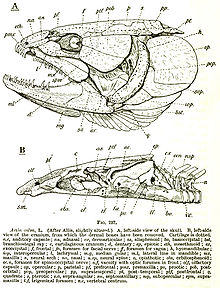
The hyomandibula, commonly referred to as hyomandibular [bone] (Latin: os hyomandibulare, from Greek: hyoeides, "upsilon-shaped" (υ), and Latin: mandibula, "jawbone"), is a set of bones that is found in the hyoid region in most fishes. It usually plays a role in suspending the jaws and/or operculum (teleostomi only). It is commonly suggested that in tetrapods (land animals), the hyomandibula evolved into the columella (stapes).[1][2]
- ^ J. A. Clack, "Earliest known tetrapod braincase and the evolution of the stapes and fenestra ovalis", Nature 369, 392–394 (2 June 1994);
- ^ R. Eric Lombard, et al., "Evolution of the tetrapod ear: an analysis and reinterpretation", Biological Journal of the Linnean Society, Vol. 11, No. 1, pp. 19–76, 1979